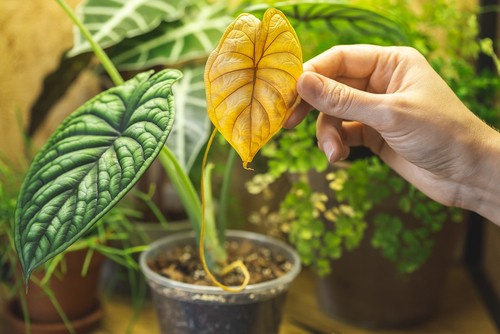Alocasia plants are known for their striking foliage and are a popular choice for indoor and outdoor gardens. However, one common issue that many Alocasia plant owners face is drooping leaves. Alocasia plant drooping can be caused by a variety of factors, including overwatering, underwatering, lighting problems, temperature stress, pests, and diseases.
Understanding the causes of Alocasia plant drooping is essential for proper plant care. Overwatering is one of the most common causes of drooping leaves, as it can lead to root rot and other issues. On the other hand, underwatering can cause the leaves to droop as a way to conserve moisture.
Lighting problems, temperature stress, pests, and diseases can also cause drooping leaves and should be addressed promptly to prevent further damage.
In this article, we will explore the various causes of Alocasia plant drooping and provide tips for proper plant care, dealing with pests and diseases, and reviving a drooping plant. We will also answer some frequently asked questions to help you better understand Alocasia plant drooping and how to prevent it.
Key Takeaways
- Alocasia plant drooping can be caused by overwatering, underwatering, lighting problems, temperature stress, pests, and diseases.
- Proper plant care is essential for preventing Alocasia plant drooping, including maintaining proper watering, lighting, and temperature conditions.
- Dealing with pests and diseases promptly is crucial for preventing Alocasia plant drooping and reviving a drooping plant.
Check out these other related posts:
Understanding Alocasia Plant Drooping
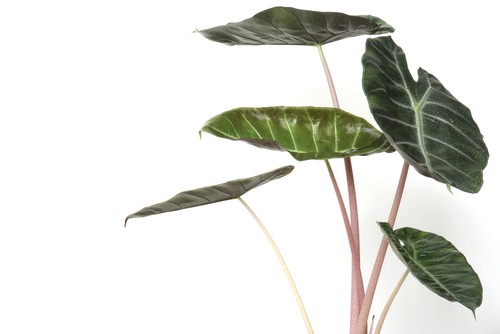
Signs and Symptoms
Alocasia plants are known for their large, striking leaves that can add a tropical touch to any indoor space. However, if you notice that your Alocasia plant’s leaves are drooping, it may be a sign that something is wrong.
The most obvious symptom of Alocasia plant drooping is the downward curling of the leaves. In severe cases, the leaves may wilt and eventually fall off the plant.
Alocasia Plant Drooping – 6 Common Problems
There are several reasons why Alocasia plants may experience drooping leaves. Understanding the common causes can help you identify and treat the underlying problem.
1. Overwatering
Overwatering is one of the most common causes of Alocasia plant drooping. When the soil is constantly moist, the roots of the plant can become waterlogged, which can lead to root rot. This, in turn, can cause the leaves to droop and eventually fall off. To avoid overwatering, make sure to allow the soil to dry out slightly between waterings.
2. Underwatering
On the other hand, underwatering can also cause Alocasia plant drooping. When the soil is too dry, the plant may not be able to absorb enough water to support its leaves. This can cause the leaves to curl and droop. To prevent underwatering, make sure to water your Alocasia plant regularly and thoroughly.
3. Lighting Problems
Alocasia plants prefer bright, indirect light. If the plant is not receiving enough light, the leaves may droop and the plant may become leggy. On the other hand, if the plant is exposed to too much direct sunlight, the leaves may become scorched and droop. To prevent lighting problems, make sure to place your Alocasia plant in a location with bright, indirect light.
4. Temperature Stress
Alocasia plants prefer warm, humid environments. If the plant is exposed to temperatures that are too cold or too hot, the leaves may droop and eventually fall off. To prevent temperature stress, make sure to keep your Alocasia plant in a location with a consistent temperature and humidity level.
5. Pests
Pests, such as spider mites and mealybugs, can also cause Alocasia plant drooping. These pests feed on the plant’s leaves, which can cause them to curl and droop. To prevent pest infestations, make sure to inspect your Alocasia plant regularly and treat any pests promptly.
6. Low Humidity
Alocasia plants prefer high humidity environments. If the air in your home is too dry, the leaves may droop and become crispy. To prevent low humidity, consider using a humidifier or placing a tray of water near your Alocasia plant.
Alocasia Plant Care
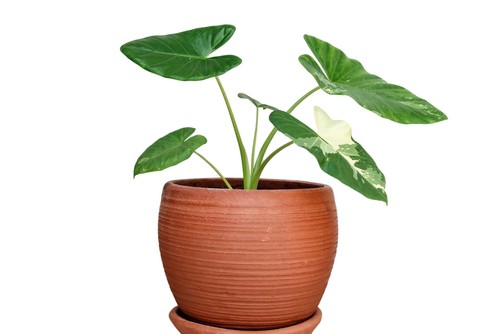
Alocasia plants are beautiful and exotic plants that require attentive care to thrive. Proper care involves providing the right amount of light, water, humidity, and nutrients. Here are some tips for taking care of your Alocasia plant.
1. Light Requirements
Alocasia plants prefer bright, indirect light. Direct sunlight can scorch the leaves, while too little light can cause the leaves to droop. Place your plant near a window that receives bright, indirect light, or use a grow light to provide the necessary light.
2. Watering Schedule
Alocasia plants prefer soil that is evenly moist but not waterlogged. Overwatering can lead to root rot and cause the leaves to droop, while underwatering can cause the leaves to wilt. Water your plant when the top inch of soil feels dry to the touch. Be sure to use a well-draining soil mix and a pot with drainage holes to prevent water from accumulating in the soil.
3. Humidity and Temperature
Alocasia plants prefer high humidity and warm temperatures. They thrive in temperatures between 60-80°F (15-27°C) and require a humidity level of at least 60%. You can increase humidity by placing a tray of water near the plant or using a humidifier. Avoid placing your plant near drafts or in areas with low humidity.
4. Potting and Soil
Alocasia plants prefer to be slightly root-bound, so choose a pot that is only slightly larger than the current pot. Use a well-draining soil mix that contains peat moss, perlite, and vermiculite. Alocasia plants are sensitive to salts and minerals in tap water, so it’s best to use distilled or filtered water.
5. Fertilizing and Nutrients
Alocasia plants require regular fertilization to thrive. Use a balanced, water-soluble fertilizer every two weeks during the growing season (spring and summer) and reduce fertilization during the dormant season (fall and winter). Be sure to follow the instructions on the fertilizer package and avoid over-fertilizing, which can lead to salt buildup in the soil.
6. Repotting and Transplanting
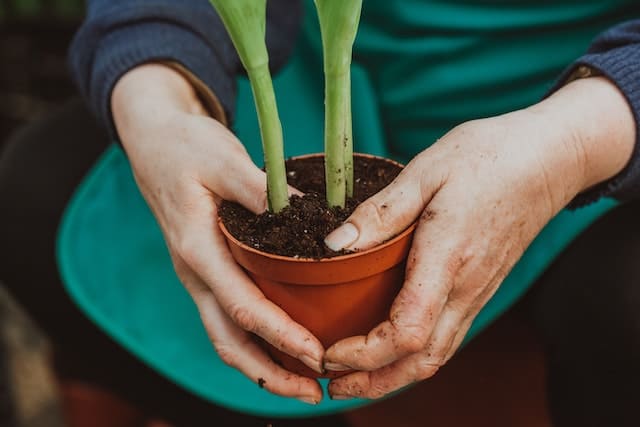
Alocasia plants should be repotted every 1-2 years to refresh the soil and provide room for growth. Transplanting should be done in the spring, before the growing season begins. When transplanting, choose a pot that is only slightly larger than the current pot and use a well-draining soil mix.
Be sure to water the plant thoroughly after transplanting to help it adjust to its new environment..
Dealing with Pests and Diseases
Identifying Common Pests
Alocasia plants can be susceptible to pests such as aphids, mealybugs, and spider mites. Aphids are small, soft-bodied insects that can be found on the undersides of leaves. They suck the sap from the plant, which can cause the leaves to curl and become distorted.
Mealybugs are small, white, fluffy insects that can be found in the leaf axils and on the undersides of leaves.
They also suck the sap from the plant, which can cause the leaves to turn yellow and drop off. Spider mites are tiny, spider-like creatures that can be found on the undersides of leaves. They can cause the leaves to become speckled and eventually fall off.
To identify a pest infestation, it is important to regularly inspect the plant for any signs of pests. Look for small insects, webbing, or distorted leaves. If you suspect a pest infestation, it is important to act quickly to prevent the pests from spreading to other plants.
Managing Diseases
Alocasia plants can also be susceptible to diseases such as bacterial leaf spot disease. This disease is caused by a bacterium and can cause brown or black spots on the leaves. If left untreated, the spots can spread and cause the leaves to drop off.
To manage bacterial leaf spot disease, it is important to remove any infected leaves and dispose of them in the garbage. It is also important to avoid getting water on the leaves, as this can spread the disease. If the disease persists, a fungicide may be necessary.
Symptoms of other diseases that Alocasia plants can suffer from include leaves that are browning, shriveling, or curling. Leaves may also appear dull and limp. To manage diseases, it is important to identify the symptoms and take action quickly.
Remove any infected leaves and dispose of them in the garbage. Adjust the watering schedule and ensure that the plant is not receiving too much or too little light. In some cases, a fungicide may be necessary to manage the disease.
Reviving a Drooping Alocasia Plant
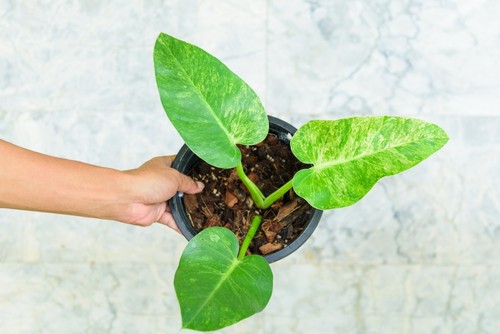
A drooping Alocasia plant can be a cause for concern for any plant enthusiast. However, with the right care and attention, it is possible to revive a drooping Alocasia. Here are some tips to help revive a drooping Alocasia plant.
1. Addressing Overwatering and Underwatering
Overwatering and underwatering are two common causes of drooping Alocasia leaves. If the soil is too wet or too dry, the leaves may start to droop. To address overwatering, allow the soil to dry out before watering again.
Use a well-draining soil mix and make sure the pot has drainage holes. If the soil is too dry, water the plant thoroughly until water runs out of the drainage holes. Check the soil moisture regularly and water when the top inch of soil feels dry.
2. Improving Light and Temperature Conditions
Alocasia plants thrive in bright, indirect light. If the plant is not getting enough light, the leaves may start to droop. Move the plant to a brighter location, but avoid direct sunlight, which can scorch the leaves. Alocasia plants also prefer warm temperatures between 60°F and 80°F. If the plant is exposed to temperatures outside this range, it may start to droop.
3. Dealing with Root Rot
Root rot is a fungal disease that can affect Alocasia plants. It is caused by overwatering and poor drainage. To deal with root rot, remove the plant from the pot and inspect the roots. If the roots are brown and mushy, remove the affected parts with a clean pair of scissors or shears.
Repot the plant in a fresh, well-draining soil mix and make sure the pot has drainage holes.
4. Treating Pest Infestations
Pest infestations can also cause Alocasia leaves to droop. Common pests that affect Alocasia plants include spider mites, mealybugs, and scale insects. To treat pest infestations, isolate the affected plant and treat it with an insecticidal soap or neem oil. Repeat the treatment every seven to ten days until the infestation is under control
Frequently Asked Questions
Why is my Alocasia droopy?
The most common reason for Alocasia drooping is incorrect watering. Alocasias prefer soil that is evenly moist but not waterlogged. If the soil is too dry or too wet, it can cause the plant to droop. Another reason for drooping is lack of light. Alocasias need bright, indirect light to thrive.
What does overwatered Alocasia look like?
Overwatered Alocasia will have yellowing leaves, soft stems, and drooping foliage. The soil will be waterlogged and may have a foul smell. Overwatering can lead to root rot, which is a serious condition that can kill the plant.
How do you keep Alocasia upright?
To keep Alocasia upright, make sure the soil is evenly moist and not waterlogged. Water the plant when the top inch of soil feels dry to the touch. Provide bright, indirect light and keep the plant away from cold drafts. Alocasia also benefits from regular fertilization during the growing season.
How long does it take for my drooping Alocasia plants to recover?
The recovery time for drooping Alocasia plants depends on the severity of the issue and how quickly it is addressed. If the plant is simply underwatered, it may recover within a few hours of being watered. If the plant is overwatered and suffering from root rot, it may take several weeks for the plant to recover, if it recovers at all.
Why is my Alocasia plant watered but drooping?
If an Alocasia plant is watered but still drooping, it could be due to root rot. Root rot can occur when the plant is overwatered or the soil is not well-draining. It can cause the roots to rot and the plant to droop. Another reason could be lack of light, as Alocasia needs bright, indirect light to thrive.
Will my Alocasia perk back up?
If the cause of the drooping is addressed, such as correcting the watering schedule or providing more light, the Alocasia plant can perk back up. However, if the plant has suffered from root rot or other serious issues, it may not recover.

Hey, I’m Lisa and I’ve been an avid gardener for over 30 years. I love writing, talking and living in the garden! Feel free to connect with me on my socials below

